
Presented by: Nori J. Muster,
a candidate for the degree of
Masters of Science in Interdisciplinary Studies, 1991
Juvenile Art Therapy
As a graduate student at Western Oregon University, 1990 to 1991, I was the art therapy teacher at a juvenile correctional institution. My students were serving their time in a behavior modification program in the sex offender ward. They were all boys, ranging in age from twelve to seventeen. Over the months I was there, I worked with approximately thirty students, but our classes were usually five to ten students at a time. Attending my classes gave the students points toward reaching their goal in the program. Attendance was voluntary, available to those who exhibited good behavior.
I began each session by passing out paper and pencils. Occasionally we used crayons or other art materials, but most of the art is in black and white. The staff at the facility forbid the juveniles from drawing pictures of skulls, skeletons, guns, knives, or any violent images. However, in my class I allowed them to draw whatever they wanted to draw. This led to some conflict between me and the staff, but I defended the art therapy process, and so the children were allowed to draw whatever they could imagine.
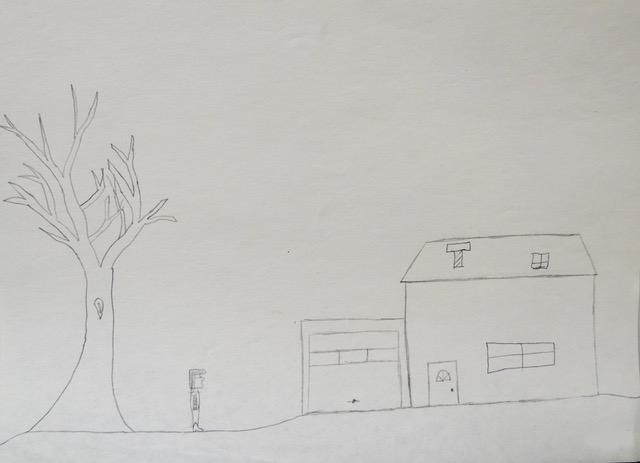
This is an example of a "house-tree-person" drawing. HTP drawings are most commonly studied for statistical research, and statistics exist for a variety of populations. This is the only HTP drawing that survives in my collection. Items analyzed for statistics include: how large or small the elements are, how the elements are spaced, how the drawing fills the sheet of paper; how the tree appears, how the person appears, and how the house appears.
In this drawing the branches of the tree are sharp, indicating violence or hostility. The tree also has no leaves and a knot hole. These characteristics have various interpretations.
The person is in proportion to the tree and house, although a little tall to make it through the front door, and is seen from the side. The person has hands and feet. Missing hands and feet may indicate feelings of powerlessness.
The house has a garage attached, and has windows. The student who did this drawing is noted as Luca, below.
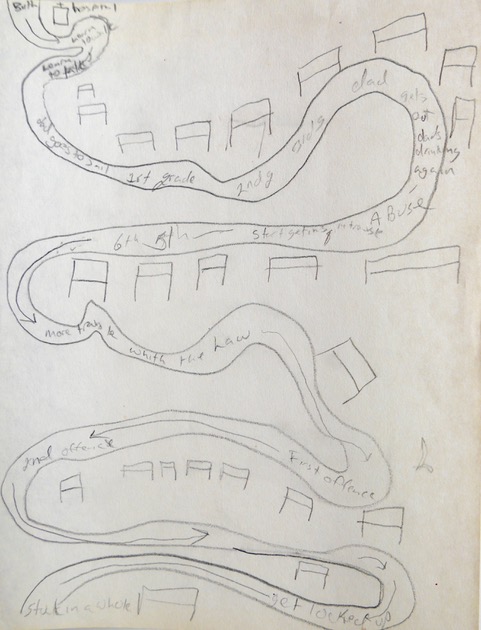
Drawing a life map is also a common art therapy exercise, and one that opens a conversation with the person who does the drawing. The transcript of this drawing is: "Born; hospital; learn to walk; learn to talk; dad goes to jail; 1st grade; 2nd grade; 3rd grade; dad gets out; dad's drinking again - abuse; start getting into trouble - 5th; 6th; more trouble with the law; first offense; second offense; get locked up; stuck in a whole." His path wraps around objects he identified as obstacles.
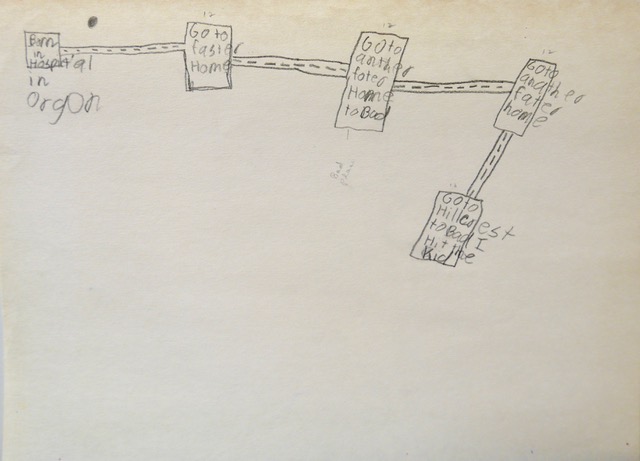
The second example of a life map is positioned across the top of the page. The use of space is also a clue to what's going on in the subject. Transcript: "born in hospital in Oregon; go to foster home [age 12]; Go go another foster home to bad [age 12, the home was a bad place]; Go to another foster home [age 12]; Go to [juvenile correctional institution where he is now] hit the kid." He told me he hit one of the kids at the foster home, so they put him in the correctional institution.
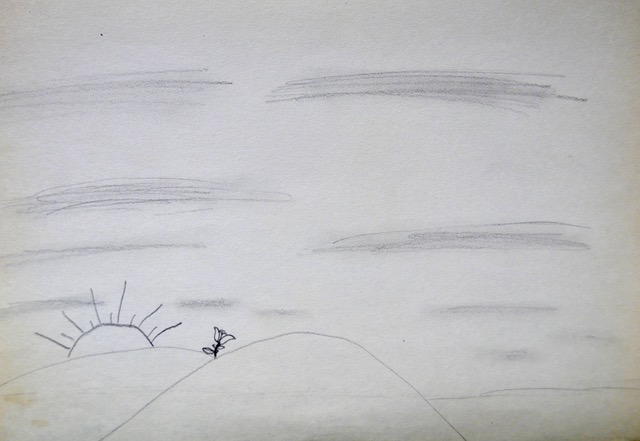
The first drawing this student did was of a rose cut off at the stem and dripping blood or tears. I asked him what it meant to him, and he said he was forced to move out of his home at the age of fourteen to enter a foster home. He continued to draw the same image every time I worked with him. This drawing shows the rose growing in a landscape, with a friendly sunrise - an improvement over a cut rose dripping blood.
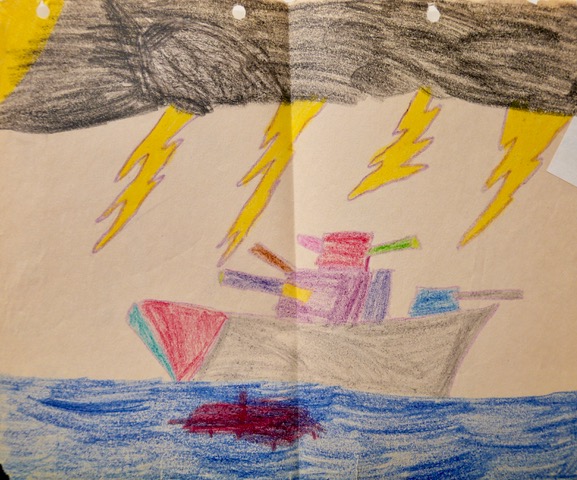
Ronald was one of my best students. (See below for his profile). His first drawing was of a battleship in a storm with blood in the water.
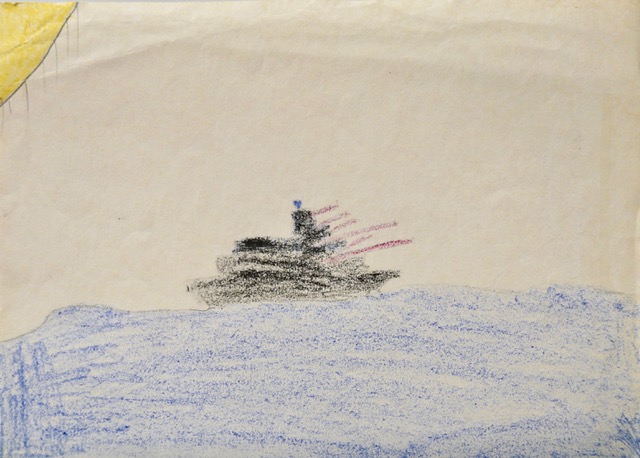
After working with him over many months, his final drawing was of the same battle ship, but under a sunny sky, in an ocean with clear blue water.
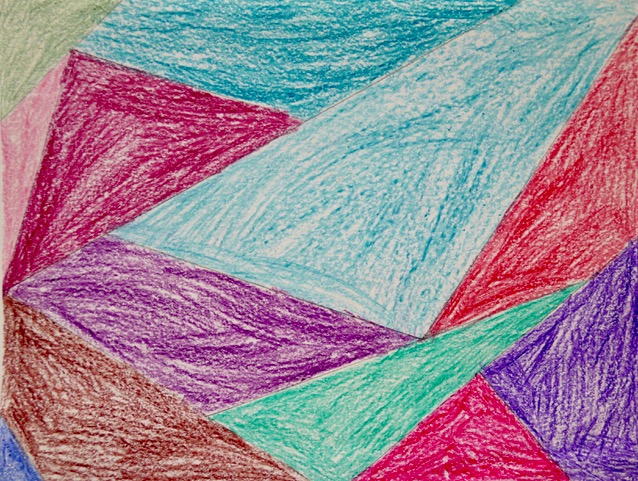
Ronald repeatedly drew these shattered glass images. He requested art materials to keep in his room so he could draw between classes. Following is one of fourteen shattered glass drawings he gave me.
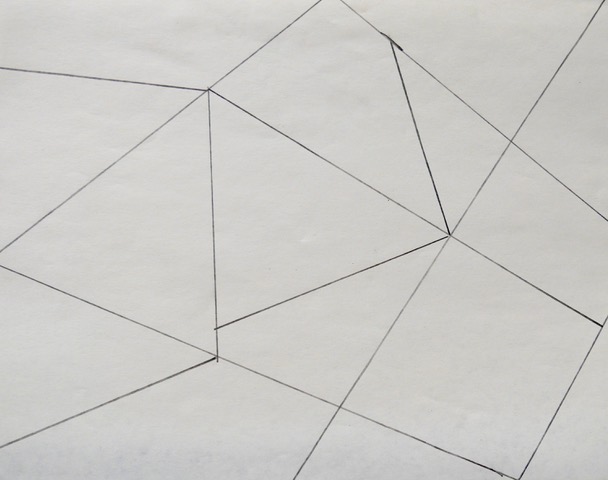

Another common art therapy exercise is to draw the two sides of self. Transcript: "After I'm in a good mood GOOD; Me when staff wake me up BAD." The student who did this drawing is noted as Jack, below.
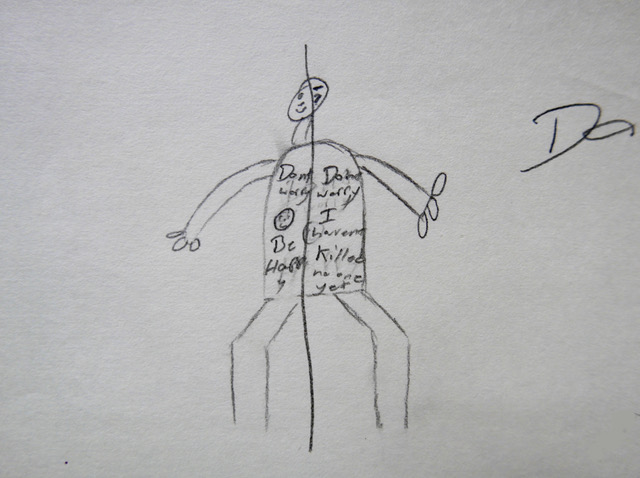
Transcript: "Don't worry be happy; Don't worry I haven't killed no one yet."
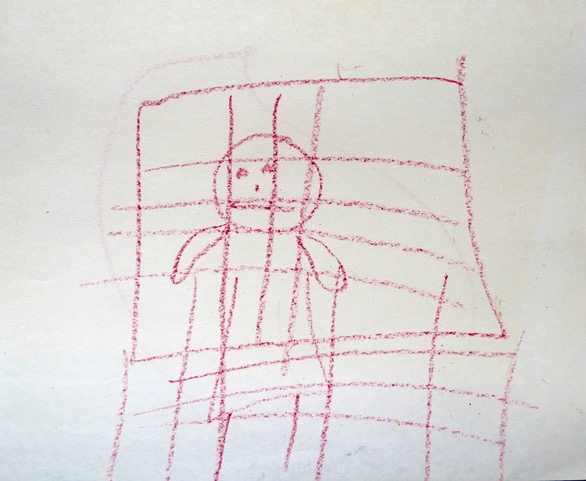
This is one student's view of himself in jail in the future. The juvenile facility didn't have bars. Note the absence of hands or feet, indicating feelings of helplessness.
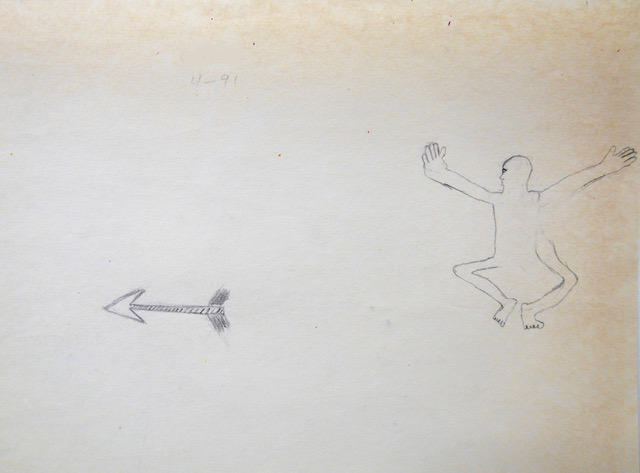
This image shows an arrow, a symbol of violence, and possibly sexual violence, detached from the body. In Gestalt Art Therapy, we don't read too much into symbols, but just ask the makers what their drawings mean to them. Following are the remaining drawings in the collection, including four that include gun violence, and three that include violence with knives.
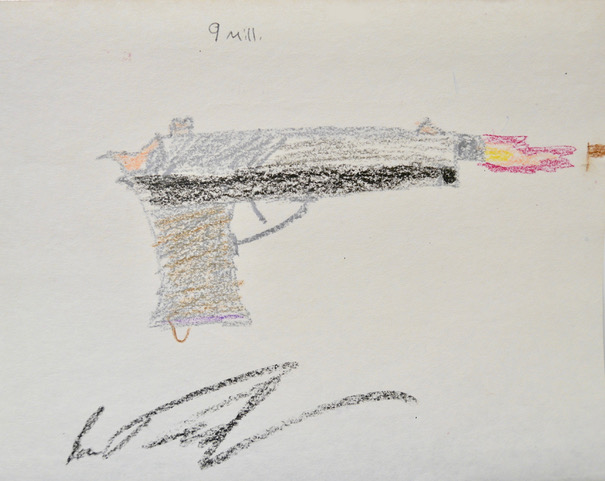
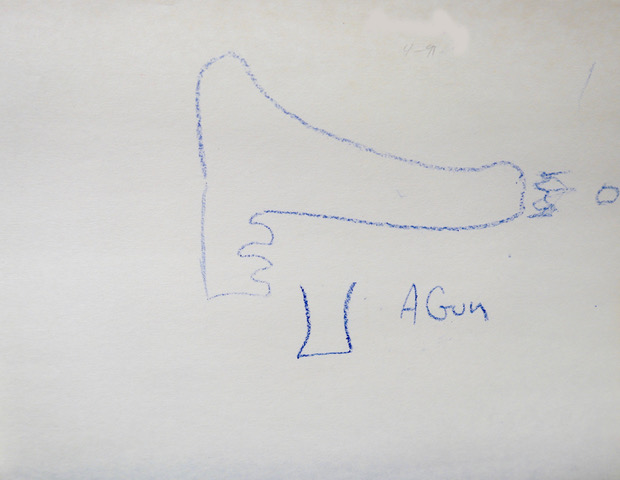
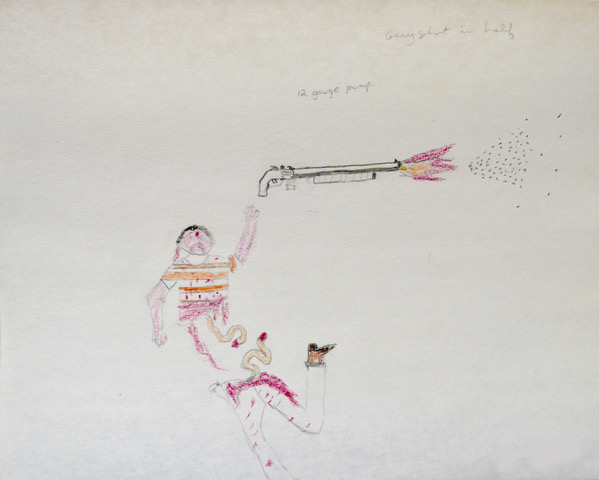
Student's notation says, "guy shot in half."
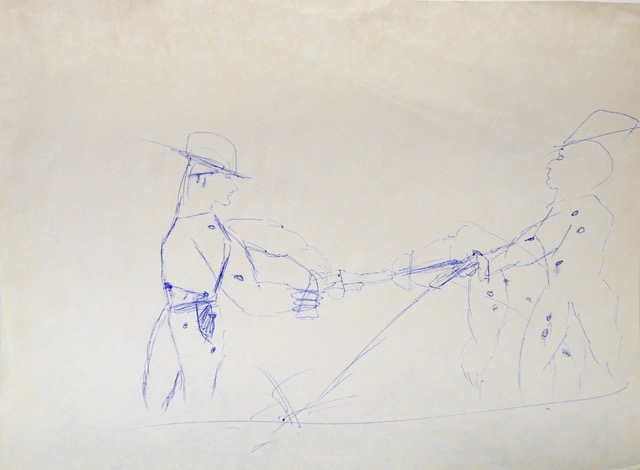
The student told me this was a shoot-out with a policeman that would probably be the way he would die. One observation - the lawman's body is reversed, facing away, possibly indicating that the policeman would be reluctant to have to kill him.
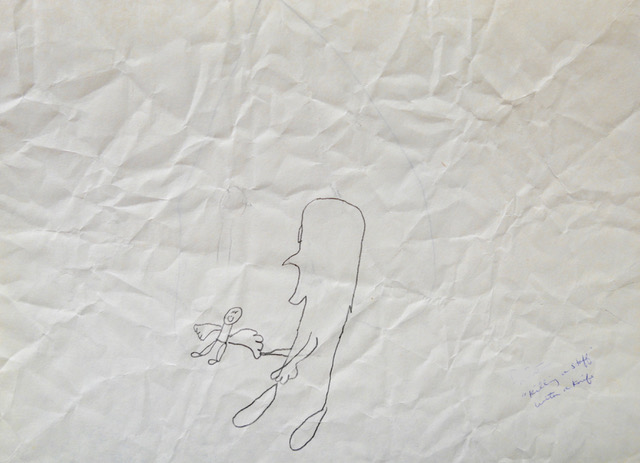
The student who did this drawing said it was a picture of him killing a staff with a knife. He quickly crumpled up the paper so the staff wouldn't see it. I flattened it out and we discussed it for some time. Needless to say, I didn't share it with the staff. Note the way the subject depicts himself as so small - he was my youngest student, age twelve. Also note his giant hands. It's possible his fantasy of killing the staff with a knife made him feel powerful. Also, as a sex abuse victim-turned-offender, note where he chooses to put the knife. All art therapy drawings are telling, but again, I only read in what the subject tells me. In this case, the symbolism is quite obvious.
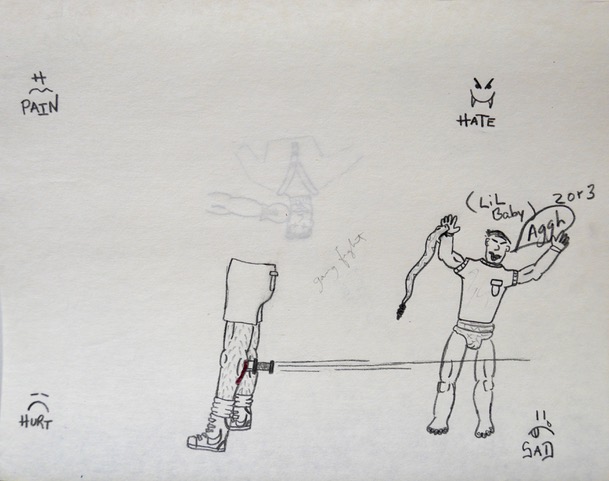
The student told me the drawing above was of a gang fight. The winner holds a winner's belt. The same student did the drawing below on the back of the paper, and told me it's a picture of his father hitting him. Note the absense of hands or arms on the figure; the only hand and arm is the boxing glove hitting him.
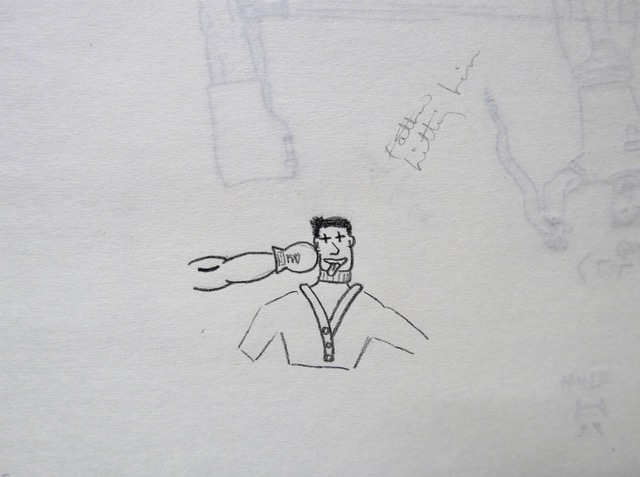
Student's Criminal Records
Each of my students had records on file in the juvenile facility's main office. The notes on their records included arrest records, juvenile court records, and notes by doctors, counselors, and social workers. I spent hours reading my students' records, taking notes. I wanted to understand the kids I was working with, since the work I was doing would become the basis of my thesis. It was my responsibility as a researcher to take their backgrounds into account.
I have changed the names and any information that might identify the students.
John
Problems with mother, behavior, placed in relative's home. Sexual abuse, sex offense. Then placed in non-official, church-related foster home. Mother afraid to take him back because of younger siblings. Sneaky behavior brought back to mother's home. Sodomy first degree, made a ward of the court. Three victims, two girls, one boy. Minimization of offender behavior. Superficial but active participation in groups; doesn't make progress. Sodomized a six year old boy, oral sex, shoplifting, pornography, arson, runaway, and "kicked out."
Sexually molested by man who lives with his grandmother. Mother was molested by her stepfather but overcame it by her belief in God (Pentecostal), John also Pentecostal. "Non-significant" sexual contact with girls as a child, explicit movies, masturbation, etc. No psychopathology, disorders, average intellect. Profound need for sexual information. No suicidal thoughts, limited guilt, inferiority, poor self-image. Stepfather beat him. Distorted beliefs about child molesting, aggressive sexual interaction, resentment, warped belief system.
Joe
Convicted of sex abuse/penetration, sexual abuse first degree, arson, criminal mischief second degree.
Sexually abused by mother's boyfriend, and his own father. Thinks others are out to get him in trouble, runs away from foster homes. Admits to acting out from ages eight to thirteen, but says he only lies and steals a little now. Cocaine, dealing. Little insight into his problems, borderline IQ, conduct disorder, solitary aggressive. Victimized three children of older brother's girlfriend. Broke windows at Les Schwab tires, broke windows and lights at Taco Time, younger sister also a perpetrator, older sister also in foster care, learning disability, considered "high risk."
Luca
First degree rape, sexually offending eight year old half-sister, five-plus incidents. Poor school record. Emotional abuse from adults. Stepfather abused him, angry about what Luca did to his daughter. Takes responsibility for his acts. Made his sister an object to express anger toward his whole family. Anger toward stepfather and resentment toward sister. Stepfather keeps pornography, has shared it with Luca. Mother in Jehovah's Witnesses, disapproves. Conduct disorder, undifferentiated type. Sex abuse issues.
Kevin
Sexual abuse first degree, father physically, sexually abused Ken and siblings. Sexual abuse going back four years, since he was fourteen. Father was giving him pot since age two. Mother's abusive boyfriend forced him to have sexual intercourse with dogs. "Kevin's progress toward critical treatment issues is reported to be marginal due to Kevin's regression into the victim stance rather than the offender."
Marco
Burglary, unauthorized use of a vehicle, theft second degree, two counts of criminal misbehavior second degree. Sexually abused by a cousin when eleven. Sexually abused by mentally disabled relative at age five. Also, exposing himself and masturbating in front of little brother. "Confront inappropriate humor, drawings, and behavior." Physical/sexual abuse, beaten with a hose, masculinity issues, isolation within family, disruptive in school, obsession with death; stealing, lying behaviors, self-conscious, unhappy, depressed, self-serving relationships, continual depression, denial, blaming, refusal to take responsibility.
Jack
First and second degree rape, two females, aged six and eight; arson first degree, animal abuse first degree, caught fondling another boy in the ward. Sexually abused at age thirteen by a seventeen year old babysitter - oral sex, anal sex at knife point. Reported to mother but she didn't believe him. Father was physically abusive, mother alcoholic and depressive. Learning disabilities, stuttering, suicidal, inappropriate affect, borderline intelligence. "Quite severely emotionally disturbed." Thought production slow, but associations connected. Fairly long history of oppositional behaviors, school failures, poor peer relations, ultimately leading to dangerous criminal behaviors. Mother said he lives in a fantasy world. May have paranoid, psychotic, or pre-schizophrenic tendencies. Axis I: conduct disorder, solitary, aggressive type, moderate to severe, stuttering. Axis II: Consider borderline intellectual functioning, acne.
Ronald
Sex abuse, penetration, sodomy, attempted Sodomy I; sexual abuse first degree. Oppositional youngster who stole, lied; distrustful of adults, omnipotent view of self. Threats of violence against family. Father physically abused him, age four. Negative attention, demanding. "Seriously dangerous, refused to be controlled." Runaway to downtown Portland with knives and blankets. Sexually aggressive toward peers. Axis I: Identity disorder, Intermittent explosive disorder; Axis II: Pervasive developmental disorder, nonspecific. "Predatory sexual offender who is untreatable and who will need to be locked up for years to come." Quest of family for an "iron clad" label. Molested while on the run from a reform school. "Extremely poor prognosis." Ronald said, "Some of my brain has been erased." Possible organic problems, difficult labor accompanied by hydrocephalus.
Ronald produced two battleship drawings; one at the outset and one at the conclusion of his participation (shown above). He also produced a drawing of the devil pushing him into hell, a desert scape, and fourteen or more shattered glass drawings.
Usually I didn't meet my students' parents, but I met Ronald's, and they told me they believed the art therapy had helped him. Before, they imagined him getting out of the juvenile detention facility, committing murder as an adult, and spending the rest of his life in prison. They told me they noticed an improvement in Ronald's attitude that gave them hope for his future.
Graduate students are welcome to replicate my study, but if you use my materials or quote from my thesis, I ask that you acknowledge my contribution to your work. Please cite me as follows in your references: "Nori Muster, author of A Four-Phase Treatment Design for Juvenile Sex Offenders, Western Oregon University, 1991."
Read thesis
more graduate work
Index